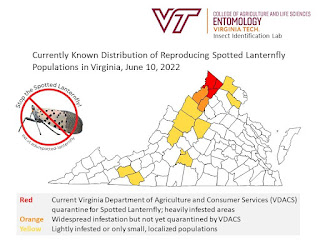Hello, everyone,
In May 2019, the Virginia Department of Agriculture and Consumer Services (VDACS) announced the establishment of a quarantine zone for spotted lanternfly (SLF). I posted on this here on 28 May of that year, and again on 3 June, when a public open house was announced to discuss compliance with the program. The quarantine zone initially contained Frederick, Clarke and Warren Counties plus the City of Winchester. A significant expansion of the zone is now planned, and will be formally announced in the next week or so. The quarantine zone additions will include the counties of Albemarle, Augusta, Carroll, Page, Prince William, Rockingham, Rockbridge, Shenandoah and Wythe, plus the cities of Buena Vista, Charlottesville, Harrisonburg, Lexington, Lynchburg, Manassas, Manassas Park, Staunton and Waynesboro. Here is the new zone map:
Here is a link to more information on the quarantine (https://www.vdacs.virginia.gov/pdf/spotted-lanternfly-quarantine.pdf). There will be public informational sessions to discuss the program, and facilitate compliance. One such meeting will be held on Aug 1, 5:50-8:30 PM, at King Family Vineyards. For more information, contact Grace Monger, gimonger@vt.edu (free with pre-registration, $10 at the gate). I will announce other sessions as I learn of dates.
One of the conditions of the quarantine is that at least one person within each company (vineyard, winery, orchard, hops yard, etc.) be certified to inspect and approve vehicles or shipments leaving the quarantine zone. The current certification program is linked here. Cost for a certification is $6.00.
The quarantine zone is being expanded because SLF continues to spread in Virginia. Different maps are prepared reflecting this spread. There are understandable differences in details among maps depending on the nature of programs - approvals that are needed for a quarantine, official identification of SLF samples, etc. Here are two current maps. The first has been developed within the Department of Entomology at Virginia Tech, by Eric Day and Theresa Dellinger. The second is maintained in a SLF site by the New York State IPM program at Cornell University.
These two maps reflect two infested counties not yet included in the quarantine: Campbell and Loudoun. An important point of the Cornell map is that it includes the whole range of SLF. A significant point here is that SLF has turned up in North Carolina, the first infestation for this state, in Forsythe County, Close to I-44. More information on the NC infestation can be seen here.
Summary: Important take-away points here are that SLF has continued its spread, now including the whole Shenandoah Valley, further incursions in the Piedmont of Virginia, and a significant jump into southern Virginia, almost certainly assisted by human transportation, at the junction of two major highways. There has been an expansion into North Carolina, close to (though not adjacent) to Carroll and Wythe Counties. VDACS is set to announce a significant expansion of the SLF quarantine zone in Virginia. Watch for annoucements of informational meetings in affected counties.
You can contact me for information on spotted lanternfly biology or management. For questions on the quarantine program itself, contact VDACS at spottedlanternfly@vdacs.virginia.gov, or 804-786-3515.
More later,
Doug
Fruit Insect News from Doug Pfeiffer (Fruit Entomologist at Virginia Tech - Blacksburg)
Subscribe to:
Post Comments (Atom)
Hello everyone, As spotted lanternfly has continued its spread, some vineyards are showing low populations for the first time, while others...
Indicia statement
Virginia Cooperative Extension programs and employment are open to all, regardless of age, color, disability, gender, gender identity, gender expression, national origin, political affiliation, race, religion, sexual orientation, genetic information, veteran status, or any other basis protected by law. An equal opportunity/affirmative action employer. Issued in furtherance of Cooperative Extension work, Virginia Polytechnic Institute and State University, Virginia State University, and the U.S. Department of Agriculture cooperating. Edwin J. Jones, Director, Virginia Cooperative Extension, Virginia Tech, Blacksburg; M. Ray McKinnie, Administrator, 1890 Extension Program, Virginia State University, Petersburg.




No comments:
Post a Comment